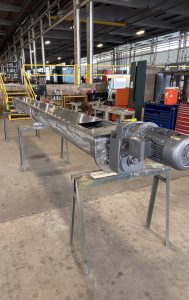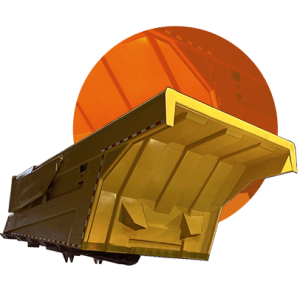In bulk material handling and industrial fabrication, choosing the right material is just as important as the equipment design itself. Two of the most common metals used in custom conveyors and components are carbon steel and stainless steel. Both have unique strengths—and choosing the wrong one can lead to premature wear, corrosion, contamination, or unnecessary cost.
At ISC Manufacturing, we build equipment to match your process—not the other way around. That starts with helping you choose the best material for your environment, your product, and your performance goals.
Here’s a straightforward breakdown of stainless vs. carbon steel, including how to decide which is right for your next screw conveyor, hopper, chute, or structural frame.

Carbon Steel: Strength and Affordability
Carbon steel is the workhorse of industrial fabrication—strong, widely available, and cost-effective.
Common Carbon Steel Grades
-
A36 – A versatile, low-cost structural steel used for frames, supports, and general fabrication. Easy to weld and form.
-
1018 – A mild, low-carbon steel with excellent machinability. Common in shafts, spindles, and low-stress parts.
-
1045 – A medium-carbon steel with higher strength and wear resistance. Ideal for pins, gears, and components under greater load.
Key Advantages
-
High strength and rigidity – Ideal for structural applications and heavy-duty conveying.
-
Lower material cost – Carbon steel is more affordable than stainless, making it ideal for projects where corrosion isn’t a concern.
-
Easily weldable and machinable – Simplifies fabrication for custom parts and assemblies.
Best Applications
-
Dry bulk materials that don’t cause corrosion (aggregates, grains, pellets, powders)
-
Indoor environments with controlled humidity
-
High-impact or high-load systems
-
Projects with tight budget constraints
Limitations
-
Not corrosion resistant – Carbon steel will rust without protective coatings.
-
Needs painting or powder coating for longer lifespan in mildly corrosive settings.

Stainless Steel: Corrosion Resistance and Cleanability
Stainless steel offers excellent corrosion protection, chemical resistance, and cleanliness. It’s often used in applications where hygiene, longevity, or exposure to moisture is a concern.
Common Stainless Grades Used in Bulk Handling
-
304 Stainless – The industry standard. Excellent corrosion resistance, cleanability, and strength. Ideal for food, beverage, and general processing.
-
316 Stainless – Higher corrosion resistance than 304, especially in marine or high-chloride environments. Common in chemical processing and pharmaceutical applications.
Key Advantages
-
Resists rust, corrosion, and chemical attack
-
Easy to clean and sanitize
-
Longer lifespan in abrasive conditions
Best Applications
-
Food and beverage production
-
Pharmaceuticals or cosmetics
-
Wet, humid, or washdown environments
-
Corrosive materials like fertilizers, salts, or acidic compounds
-
Outdoor or coastal applications
Limitations
-
Higher cost – Stainless is more expensive than carbon steel
-
More challenging to fabricate – Welding and forming require more care and time

316 Stainless Steel Covered Feeder
What About Wear-Resistant Steel?
For high-impact, abrasive environments—like screw conveyors handling aggregates or mining materials—standard carbon steel may not hold up. That’s where AR (Abrasion Resistant) steel and Hardox come in. These steels, such as AR400, AR500, and Hardox 500, are designed for extended wear life in high-friction conditions. While not always necessary, these specialty steels are ideal for extreme-duty applications like mining, cement, and aggregate handling. Though more expensive upfront, they significantly reduce downtime, maintenance, and replacement frequency in harsh operating environments.

So Which Should You Choose?
Choosing between carbon and stainless steel depends on three main factors:
1. Material being handled
If your material is corrosive (like fertilizer, brine, or chemical byproducts) or must remain uncontaminated (like food or pharmaceuticals), Stainless Steel is the better choice.
For dry, non-reactive materials like sand, pellets, or grain, Carbon Steel is often sufficient.
If you’re handling abrasive, high-impact materials like aggregates consider Wear-Resistant Steel (like AR400, AR500, or Hardox) for extended equipment life.
2. Operating environment
For wet, humid, coastal, or washdown environments, Stainless Steel provides long-term corrosion protection.
In dry indoor facilities, Carbon Steel performs well at a lower cost.
In high-wear settings where downtime and part failure are costly, Wear-Resistant Steel adds serious longevity.
3. Budget and performance balance
If upfront cost is the priority, Carbon Steel offers savings.
If long-term performance, cleanability, or reduced maintenance is critical, Stainless Steel can deliver better value over time.
For extreme-duty applications, investing in Wear-Resistant Steel may dramatically lower lifetime maintenance costs.
Let ISC Help You Get It Right
At ISC, we don’t just build screw conveyors—we engineer complete, purpose-built solutions that last. We’ll help you weigh the pros and cons of carbon vs. stainless steel and choose the best construction for your specific application.
Whether you need an all-stainless system for food-grade processing or a rugged carbon steel conveyor for dry bulk, we deliver equipment that’s built for the job.
Contact us today to discuss your project and get expert material recommendations.
📞 817‑641‑0691
🌐 www.iscmfg.com



